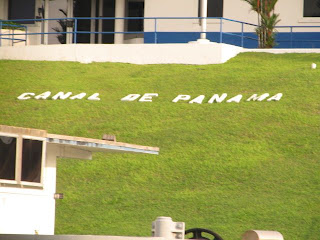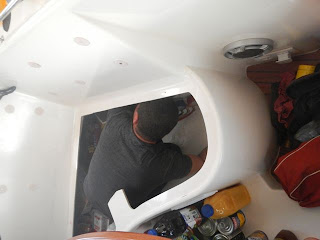Before going into our transit experience a short and factual discourse on the history of the Canal might be a good idea.
· 1534 – the Spanish first conceived the idea of creating a passage to transport the spoils of their depredation of South America from the west coast of Pacific to the Atlantic on the way to Spain
· 1855 – Panama Railway Company established first connection by rail
· 1879 – Ferdinand de Lesseps [also constructed Suez Canal]. His plan of constructing a canal across the Isthmus with 25 locks was too complicated and after the loss of millions of francs and 25.000 lives the company went bankrupt
· 1894 - second French attempt using the same idea failed
· 1903 – Panama separated from Greater Colombia to become a Republic and engaged with Roosevelt to realize the novel idea of flooding the Chagras river to create an artificial waterway with 3 locks leading up from the Atlantic to Lake Gatun and 3 locks down to the Pacific.
· 1914 – the first ships crossed the Isthmus
· 1999 – the American lease for the canal territory expired and after a 20 year transition period the Panamanian people took over complete ownership and management of the Panama canal
3012275 – that was our Panama Canal Ship Identification Number for the transit. After having transited twice before as hired line hands for other yachts our transit date was set for May 14/15. On the day we were all set with wrapped car tires as additional fenders and 125ft long lines. Apart from ourselves the 2 extra line hands for our crossing were father/daughter team Mark and Marissa from NZ. We weaved our way through the waiting ships and at 1530h picked up Freddy, our advisor in the ‘flats’ outside Cristobal harbor.
Almost 100 years after the inauguration of the canal the locks are still operating more or less in their original size and condition and are testimony to an incredible technical achievement at the time and reflect an unprecedented foresight into what the future merchant shipping might require.
We had the [fortunate and unfortunate] opportunity to testify this prescience by being allocated a spot in the locks going up to Lake Gatun behind what is referred to worldwide as a Panamax. With a total width of 106ft these monster bulk carriers are purpose built to maximize the load carried through the 110ft wide lock chambers.
The little space left between the stern of ‘Demeter Leader’ and the lock gates was filled with our ‘nest’ of 3 yachts. First we were allocated to raft up with the small mono hull ‘Magic’ only, but minutes before the locks closed a 72ft steel schooner suddenly appeared and joined our nest. Because of the rush the constellation of the 3 yachts was wrong and when entering the chamber the 60 tons of the steel schooner pushed us hard against the lock wall and only with some firm manual interference and thanks to our tires we avoided getting hull damage. The spectacle [and all the women on the three yachts of course] were closed watched by the crew on the bulk carrier …. they apparently enjoyed themselves.
Going through these first three consecutive Gatun Locks was no less than ‘very interesting’ and we were all surprised to come out unscathed. 50 billion gallons of water are flooding the chamber in about 8-12 minutes. This creates enormous water turbulences and the additional prop wash by the bulk carrier when assisting the ‘mules’ [locomotives] moving it into the next lock stretched our lines to the limits We feared that the lines would snap sending our ‘nest’ into a spin or the tension would rip out our cleats. It took some serious wrestling with the lines to stabiles the nest and our gloves came in handy.
2 hours later we looked over our shoulders to say good-bye to the Atlantic and left the last chamber to go into the Lake Gatun. Although we were all glad it was over it was nevertheless a great experience.
We anchored for the night on Lake Gatun and at 0630h the next morning we were joined by our new advisor Moises and motored the 28 miles across Lake Gatun.
Halfway across the lake Moises received notice that an advisor’s instructor and 2 trainees, the first 2 female advisors-to-be would replace him. After the exchange and the third lot of advisors taking charge we continued on our merry way through the Gaillard cut, the narrowest part of the canal towards Piedro Miguel Lock and finally the Miraflores Locks. On the way we saw Titan, a massive crane given to the Canal as a present by Germany. An old coalmining crane it was extensively adapted and is now used to exchange the lock gates. We then passed under the new [guess what] German built Centennial Bridge. One of the conditions to be allowed to go through the Canal is to be able to motor at a continuous speed of 6 knots. Magic, our nesting companion from the day before was pushing too hard and got stuck with some motor problems. We offered our assistance but they already frantically worked on replacing their water pump.
The bulk carrier we shared the chambers of the Gatun Locks with was luckily not scheduled to continue with us on the other side and the water turbulences going down the locks are also much less intense - hence the experience of the first day was not repeated.
We had an easy ride down the Piedro Miquel Lock being nested to a tourist boat. The steel schooner from the day before was tied up further down the chamber alone, on the lock wall. We crossed the small Miraflores Lake and then were joined again by our companions on Magic, who managed to solve their problems just in time to catch their allocated time slot with us and avoid very expensive towing charges should they have required assistance.
At 1350h on May 15 the large gates of the Miraflores Locks opened. Like millions of others before ‘we made it’ and looked down the last part of the shipping lanes towards the legendary Bridge of the Americas … and in the distance the Pacific was beckoning with new adventures.
We called into the marina at Flamenco Island and filled our diesel tanks and all other jerry cans we had on board and dropped anchor in Panama bay. The view of the skyline of Panama City seemed unreal and the next time we will see anything like this again will be on the other side of the Pacific – may be the Gold Coast in Australia.






























































